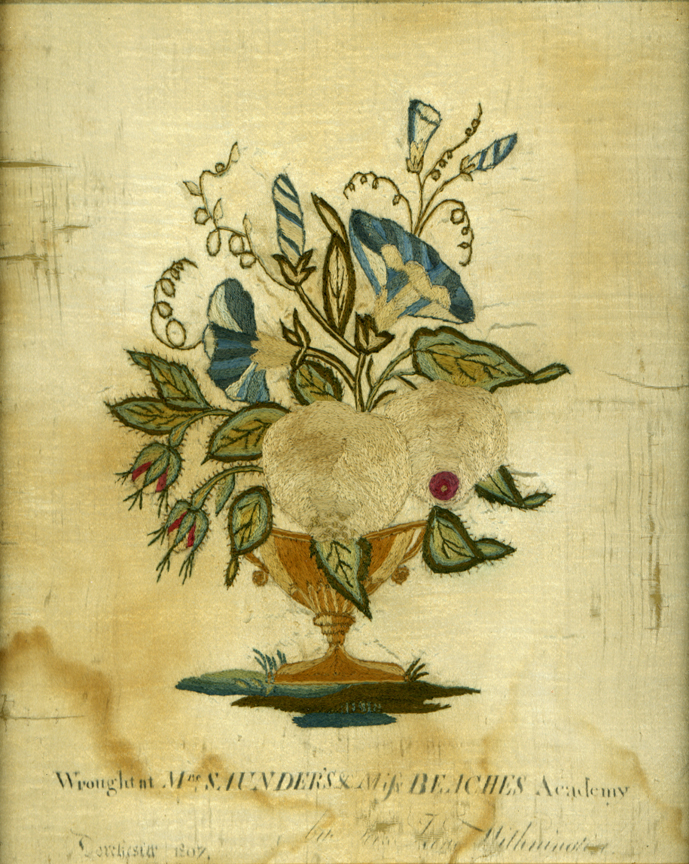Dorchester Illustration no. 2452 Needlework from centuries past
We are continuing to share the Society’s collections by email and through other online methods.
Today’s illustration features a piece of decorative needlework stitched on silk. Jane Withington was a student at Mrs. Saunder’s Miss Beaches [sic] Academy on Meeting House Hill in 1807.
The Jane Withington who is likely to have made this piece was the daughter of Edward Withington and Eunice Tucker, one of ten children. She was born in Roxbury, May 3, 1790. Jane would have been 17 years old when the needlework was done. Then five years later she married Jacob Howe in Dorchester on Aug. 20, 1812. Jacob’s brother Samuel married Jane’s sister Eunice. Source: Henry Withington of Dorchester, Mass., and Some of his Descendants. By Frederic Scherer Withington. NEHGR (1921) p. 142-270, specifically p. 205. This is the only Jane Withington who would have been the right age in 1807 to be a student in Mrs. Saunders’ & Miss Beach’s Academy.
The Dorchester Historical Society collections include examples of needlework and samplers from three centuries of Dorchester history. Many of these pieces were worked by young women as part of their education to show their proficiency with needle and thread.
Much of the following is from American Samplers by Ethel Stanwood Bolton and Eva Johnston Coe. (Boston: Massachusetts Society of the colonial Dames of America, 1921)
The curriculum at Miss Glover’s School and at the Saunders and Beach Academy included decorative needlework as one of the courses of study. One of the popular types of needlework created by young women was the sampler. Samplers began as a way of recording examples of stitches; therefore, a sampler was an exemplar of the various stitches that a young woman had mastered and wanted to remember. In the twentieth century, we have come to call any needlework signed and dated by the maker by the name of sampler. Perhaps the secret charm of samplers was that they were distinctly the expression of the mind of the girl or her mother or her teacher, and so they are pretty nearly as varied as the mind of man. In the second half of the eighteenth century, samplers became more original pieces of work incorporating images of leaves and flowers, houses, dogs and birds, and other scenes from nature.
Most of the known surviving needlework pieces were created by schoolgirls. By the mid-eighteenth century there were many schools serving to round out the education of young women. Some were finishing schools designed to teach the arts of conversation and comportment. Others called themselves academies and offered instruction in languages, reading, geography, and mathematics. Both finishing schools and academies offered needlework instruction as vehicles for religious instruction and for furthering education in mathematics and the basics of the English language.
Much of the emphasis in the curriculum was placed on needlework as evidence of a young woman’s domestic accomplishments. As Americans grew more sophisticated, so too did their style of needlework. Working the alphabet into needlework design began in the seventeenth century. Pictorial embroideries on silk were an eighteenth-century art requiring special technique demanding infinite patience.
The origins of decorative needlework are lost in ancient times long before recorded history began. Certainly many images come to mind: native American costume, clothing from the ancient Orient, textiles from early Greece and Rome. The art of embroidery began in the Middle East in ancient times. Some early examples of un-dyed woven linen embroidered with blue and red silk threads that are now housed in the Museum of Fine Arts, Boston, came from the Mamluk period in Egypt.
Needlework in western culture came to prominence in the Medieval period. The tenth through the fourteenth centuries are now known as the golden age of embroidered textile art. Garments with elaborate embroideries taking years to complete were deemed of more value than gold. The needle-workers’ art was painstaking to the extreme and, indeed, the very threads they used had to be spun and dyed by hand even before the decorative art of embroidery could begin. The earliest reference to needlework samplers comes from a 1502 list of expenses of Elizabeth of York in England. This entry concerned 8 pence given for an ell of linen cloth “for a sampler for the Queen.” There are numerous references to needlework in English poems and plays that show the popularity of the form.
The first settlers in New England in the seventeenth-century included young women who brought samplers with them to the New World. There are occasional references to the textile arts in early documents, but only very few examples remain. Bed rugs and hearth rugs are some of the extant examples of this early work. The growing sophistication of the colonists over two hundred years in New England resulted in greater demand for decorative arts in the home.
For other resources sharing Dorchester history, see www.dorchesteratheneum.org and www.dorchesteratheneum2.org

